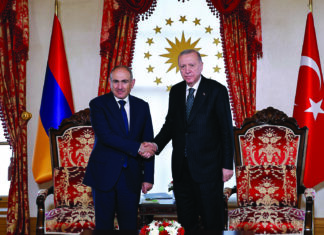YEREVAN/ SAN DIEGO — American author Claire Hsu Accomando, born in 1937 in Switzerland to Chinese and French-Armenian parents, graduated from New York University with a degree in biology and chemistry. For many years she taught art history and English at California University, also worked at Sweetwater Union High School District. In 1993 Claire Hsu Accomando published her memoirs Love and Rutabaga: A Remembrance of the War (St. Martin’s Press), which has been published also in French translation in 2021. She published essays and poems in Women in World History, The Christian Science Monitor, American History Magazine. Ararat, Artweek, Promising Practices, City Works, Atlanta Review, San Diego Poetry Annual, etc.
Dear Claire, we have corresponded for many years, although we have never met in person. The initial interest in your book, Love and Rutabaga, was due to my admiration of Babaian sisters, the three Paris-based Armenian artists. One of them, pianist Shushanik (Suzanne) Laloy Babaian (1879-1952), is your Nani (granny in Armenian) — one of main characters of your book. And since our interview is going to be read by an Armenian audience, it will be focused mostly on the Armenian part of your heritage. Being born in a multicultural family you have richness of various background.
I feel enormously enriched by my Armenian ancestry. My grandmother, Shushanik Babaian, whom I knew as Nani, was my first best friend. My grandparents’ bedroom was mostly my grandmother’s domain. Grandpapa had his bureau on the third floor of the old ancestral home in the French village where we spent four years with them during World War II. Opening the door of the bedroom was like entering Ali Baba’s cave. Treasures of all kinds filled the room. The smell of lavender permeated the air.
At night, red, blue and purple shapes decorated the walls of the room. They shifted as the colored-glass lantern hanging from the ceiling swayed. Nani had a carved armoire with drawers filled with scarves that reminded me of dragonfly wings. Shelves held boxes crammed with jewelry she had brought from Tiflis [Tbilisi]. As I tried on the heavy silver necklaces and bracelets encrusted with shiny stones, she told me and my brother about Scheherazade and ferocious Cossacks who consumed food from their saddles so as not to waste time as they ravaged the countryside.
We loved to hear about her childhood. Our favorite story was the one in which, when she was a toddler, her parents feared she had fallen off a horse-drawn sleigh. After retracing their course and looking everywhere, they discovered she had been asleep under a heavy fur blanket.
Your grandmother was the first interpreter of one of most beautiful piano pieces, Shushiki by the iconic figure of Armenian people, Komitas Vardapet. He also has sent a congratulating card addressed to Luis and Shushanik Laloys on the occasion of the birth of their daughter — your mother, Nicolette Laloy Hsu (1906-1995). It has been included in collection of letters by Komitas, published in Yerevan. Is there any memory that your family kept from Komitas and which you can share with us?











